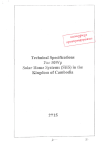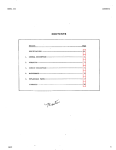Download SERVICE MANUAL MODEL 1701/1 702 MONITOR
Transcript
SERVICE MANUAL MODEL 1701/1 702 MONITOR ADJUSTMENTS - PI AND WHIT PICTURE TUBE The picture tube is a precision in-line gun type. For this picture tube, dynamic convergence is carried out by a precision deflection yoke which eliminates the use of a convergence yoke and a convergence circuit. The adjustment of the picture tube is therefore made easier as only the adjustment of static convergence by using a magnet is enough. The deflection yoke and purity/convergency magnets assembly has been set at the factory and requires no field adjustments. However, should the assembly be accidentally jarred or tampered with, some or all adjustment may be necessary. COLOR PURITY & VERTICAL CENTER Loosen yoke retaining clamp (Fig. 2-l ). With a sharp knife, cut between the picture tube and the wedge. Remove wedges completely and clean off dried adhesive from the picture tube. PAINT is used to lock the tabs of the purity/ convergence magnet assembly in place (Fig. 2-I). The paint must be removed with the end of a screwdriver before any adjustments are attempted. 1. Inject a Video Signal (RASTER) to the Video input terminal. 2. Let the purity tabs come in line horizontally as is shown in Fig. 2-3. A long tab should be in the same direction as the other short tab. 3 Move the yoke slowly backward. 4. Turn the green cut-off control to maximum and the red and blue cut-off controls to minimum. Then adjust the screen control so that the green band can be seen best. (Fig. 2-4) e direction with them 5 Rotate the two tabs in the opposite kept at an angle. Move them in either direction so that the green band is centered on the picture tube. 6. Check the vertical center position by displaying a horizontal line. If incorrect, bring it to the center by rotating the two tabs, kept at an angle, together in either direction. (Fig. 2-5, 2-6) 7. Repeat steps 5 and 6 alternately until the green band and the vertical centre are in line. 8. Move the yoke slowly towards the bell of the tube so that the whole surface of the picture tube is filled with a pure green raster. 9. Turning the red cut-off control to maximum and the green cut-off control to minimum, check for pure red raster. 10. Turning the blue cut-off control to maximum and the green cut-off control to minimum, check for pure blue raster. 1 1. Secure yoke retaining clamp (do not install wedges at this time). ITY, CON VERGENCE 3ALANC . /=I <WEDGE ,DEF. YOKE RETAINING CLAMP FOUR POLES LOCKING RING PURITY MAGNETS (mark “P”) Fig. 2-1 (REAR VIEW) SHORT AND LONG LONG AND SHORT PROTRUSIONS Let the protrusions come in line Fig. 2-3 BA (FRONT VIEW) ND CENTRE Bring the green band to the centre. (FRONT VIEW) I Bring the horizontal line nearest to the white notches shown in the dotted circles. Fig. 2-5 1 Fig. 2-4 (TOP VIEW) Select the cut-off service switch from N to S, and a horizontal line will appear. Fig. 2-6 4 (FRONT VIEW) STATIC CONVERGENCE & DYNAMIC CONVERGENCE Static convergence is achieved by four magnets located on the neck, nearest the base of the picture tube. The front pair of magnetic rings (closest to the purity tabs) are adjusted to converge the red and blue crosshatch lines. The rear pair of convergence rings (closest to the base of the picture tube) are adjusted to converge the magenta (Red/Blue) and green crosshatch lines. Dynamic convergence is achieved by tilting the deflection yoke, Up-Down and Left-Right. 1. Inject Video Signal (CROSSHATCH) to the Video input terminal and adjust BRIGHTNESS and CONTRAST control for distinct pattern. 2. Adjust the convergence around the edges of the picture tube tilting the yoke, up-down and left-right. Temporarily install one wedge at the top of the yoke. (Fig. 2-9, 2-l 0, 2-l 1) 3. Rotate the front pair of tabs as a unit to minimize the separation of the red and blue lines around the center of the screen. To adjust the convergence of red and blue, vary the angle between the tabs. 4. Rotate the rear pair of tabs as a unit to minimize the separation of the magenta and green lines. (Fig. 2-8) 5. Adjust the spacing of the rear tabs to converge the magenta and green lines. 6. Apply paint to fix 6 magnets. 7. Remove the wedge installed temporarily on the yoke. 8. Tilting the angle of the yoke up, down and sideways, adjust the yoke so as to obtain the circumference convergence. (Fig. 2-10, 2-l 1) 9. Insert three wedges to the positions as shown in Fig. 2-l 2 to obtain the best circumference convergence. 10. Secure wedges in position with the adhesive backing provided or use a non-conductive silicon/rubber compound. 11. White balance adjustment (Black & White tracking) can now be performed. (FRONT VIEW) I 1 Fig. 2-7 Fig. 2-8 (REAR VIEW) l--is/ WEDGE 0) \ DEF. YOKE Fig. 2-9 (FRONT VIEW) Tilting the yoke upward will move the lines as shown with the arrows. Fig. 2-10 (FRONT VIEW) WHITE BALANCE ADJUSTMENT (Black and White Tracking) 1. Inject a Video Signal (RASTER) to the Video input terminal. 2. Set the red and green drive controls for their mechanical center. 3. Turn the red, green and blue cut off controls and the screen control fully counterclockwise. 4. Change the service switch as shown in Fig. 2-6, to the “S” position. 5. Turn screen control slowly clockwise until a very faint horizontal line appears. 6. Turn the cut off control of the color which has appeared first, clockwise by about 10° and then adjust the screen control again so that the color may shine faintly. 7. Turn the other color cut off controls slowly clockwise until a reasonable white line appears. 8. Return the service switch to normal (N) position. (Fig. 2-6) 9. Adjust the red and green drive controls for best white highlights. Tilting the yoke upward will move the lines as shown with the arrows. Fig. 2-11 (REAR VIEW) ANODE CAP Fig. 2-12 5 NOTE: 1702 locations in ( ). Bl VOLTAGE - inject a video signal 1701 (11OV) Regulate VR, R109, for B, adjustment so that D C voltage between TP-91 and earth is 110 volts. 1702 (125V.) Confirm that the voltage at TP-94 and IC901 pin 4 is 125 volts. NOTE: Meter should be periodically calibrated at 20K ohms/volt. FOCUS Adjust the FOCUS control for best overall definition and picture detail at normal brightness and contrast. VERTICAL POSITION Adjust the V. center VR R428 (R429) to the optimum vertical picture position. VERTICAL HEIGHT AND LINEARITY 1. 2. 3. 4. Display a pattern which allows easy Reduce the vertical size with the V. Adjust the vertical linearity with the Readjust the vertical height, so that confirmation of symmetry (such as a circle or crosshatch). HEIGHT VR. V. LIN. VR. the picture extends to normal size. HORIZONTAL WIDTH Adjust H. WIDTH control coil L503 (L522) by turning it with a hexagonal adjusting bar only if RIGHT and LEFT sides of picture can’t be seen. HORIZONTAL OSCILLATOR 1. 2. 3. 4. 5. Set the H. FREQ. VR to the mechanical center position. Connect a jumper clip between TP-33A and TP-33B. While rotating the H. FREQ. VR, R504, keep the picture stationary or slowly moving. Remove the jumper wire. Make sure that the set maintains horizontal sync, when signals are switched. 6 SUB TINT AND SUB COLOR 1. 2. Display a picture and set the tint and color VRs on the control panel to the central click position. Adjust the sub tint VR, R305 and sub color VR, R303 for the optimum display. SUB CONTRAST AND SUB BRIGHT 1. 2. Display a picture and set the contrast and bright VRs on the control panel to the center click positions. Adjust the sub contrast VR, R209 and sub bright VR, R22 (R863) for optimum display. COLOR SYNC 1. 2. 3. 4. 5. 6. Display a color video signal. Connect jumper clips between TP-40 and earth (TP-E) and between TP-51 and IC301 pin 15 (TP-51B). Use a non-metallic screwdriver to turn trimmer capacitor C308. Adjust so that the rolling color stripes become thick and the rolling slows or stops. Remove jumper clips. Confirm that color sync is not disrupted when signals are switched. 3.58 MHz TRAP 1. 2. 3. Receive a Video Signal into the Video input terminal. Connect oscilloscope probe to DL201 (Delay Line) output side. Turn the core of T201 so that that 3.58MHz signal is minimized. I MINIMUM TROUBLESHOOTING GUIDE _. . - No raster, no sound (BI is. normal) I--- ~ NOTE: 1702 locations in ( 1. I [Cause] Horizontal deflection circuit Problems in the horizontal deflection circuit hinder generation of high focusing voltage, B H 16OV and 82 12V, resulting in no raster, no sound. 1. As long as normal B H 160V is generated, the horizontal output circuit properly operates, producing pulses during the flyback period of the saw-tooth wave current passing through the horizontal deflection coil. If a problem is found with normal B H voltage, the problem area should be the secondary coil of the flyback transformer. 2. When the AC voltage between base and emitter of the horizontal output transistor X01 (Q522) is about 0.8V, it is supplied with input pulses. The problem is therefore in the horizontal output circuit. When, however, X01 (05221 is shorted, this AC voltage is not indicated even if there are input pulses at X01 (0522). 3. AC voltage is measured between the collector and ground of X501 IQ521 1 horizontal drive as shown. When the specified voltage is shown on the meter, the horizontal output circuit is the problem; while, when there is no voltage indication, the trouble is in some element(s) preceding X501 (Q521 I. Check if those transistors and ICs are damaged using a voltage measurement. ABNORMAL I Check X701 (Cl5011 1 Vc, Ve at X701 (Q501) X-Ray protector I II 1I NORMAL Is normal l3H 16OV generated? NORMAL NO 4 Failure in T502, L504 (TOI. L523) or high voltage module I’ II I I More than AC 50 V Check Vc at X01 IQ5221 horizontal output transistor ABNORMAL (Trouble in horizontal output circuit) Check AC voltage between base & emitter of X01 (Q522) horizontal output transistor AC = 0.5V*Trouble in horizontal output circuit 11 ov I Check T501 (T5211 primary coil, Check AC voltaf- h-+S-,nacollector & grou fC52T 1 ~__:_.._.*, lurlrvllral drive L’ . Il *. -.i*. No raster, no sound (BI is abnormal) _. . - NOTE . 1. The regulator PCB assembly used in 1702 models differs from the 1701 1702 locations in ( power PCB assembly. The B1 voltage circuits should be checked beginning with IC901. [Cause] Abnormal Bt voltage indicates trouble in the power supply circuit. When B1 voltage is not only low but also abnormally high, X701 (Q501) of the X-ray protector is turned on, setting the collector voltage to 0 V. The horizontal oscillator is then disabled resulting in no raster and no sound. 1. When D105, R105, R108, R109 are open, the base voltage of Xl01 and X102 rise to increase Bl voltage to more than 13OV. This causes the X-ray protector to work, resulting in no raster. 2 If the base voltage drops as when R103 is open or Cl 05 is shorted, the B1 voltage is reduced to less than 40 V. This will mostly result in no raster, no sound. 3 When the B1 voltage drops to about 70 V, because R910 is open and D105 is shorted, the screen becomes dark and the raster size is reduced because of insufficient horizontal and vertical amplitude. 4 YES NO Can BI be adjusted to 1 IO V with BI ADJ RI09? r--- ------------______ -I NO YES Misadjustment Horizontal deflection circuit has failed when picture is 1 smaiiwithB1 = I I O V . Rectifier including power transformer has failed. supply Does the base voltage at XI01 change pJ+&_ + YES Is the emitter voltage of XI02 correct? Does the emitter voltage of XI 01 change with BI ADJ RI09? I NO + YES X101, RIO3 open X02 has failed * *.-.i. =*__ 18 . No picture (no raster) with normal sound . NOTE: 1702 locations are in ( 1. I [Cause] Malfunction of the video amplifier IC201, X202 (lC201, Q201) The video signal and the audio signal output are supplied respectively to the video amplifier IC201 and the audio circuit IC601. Sound is had but no picture; therefore, the faulty part is IC201 and its external elements. Since pin 16 of the IC201 to the cathode of CRT is connected by a DC-coupled amplifier, a fault raising the emitter voltage of X202 (Q201) will cause the three initial ouptut transistors to cut off, resulting in no raster. Check also the screen grid circuit for igniting the CRT heater and the high voltage module. No sound (with normal picture) NOTE: 1701 - Flowchart 1702 - Audio circuit has been reduced to IC601. [Cause] Trouble in the audio circuit IC601, X601, X603 or X604 are faulty. NO YES 17V at IC601 - pin 14? NO l l C608 (short) R605 open _ * . . . “___ ..i _ 19 . Only single horizontal line, normal sound . NOTE: 1701 - First check if FR401 is broken or not. If this is broken, the trouble is due to short of X401 or break of D401. 1702 - Circuits in 1702 monitor differ but the operation remains the same. Check vertical controls/deflection circuits. [Cause] Malfunction of the vertical deflection circuit. When the vertical deflection circuit is faulty, saw-tooth current is not applied to the vertical deflection coil, resulting in a single horizontal line. D u r ing troubleshooting, reduce brightness contrast to prevent an ion spot on the CRT. 1. R401 broken, C403, D402, C413 short: B2 12V is not supplied, disabling IC501. 2. R411, R412 broken, C407 short: the voltage at IC501 pin 3 is set to zero disabling the V-amplifier and the voltage at pin 2 is set to zero to turn off X402. 3. R414, R415 are broken: V B of X401 is zero disabling X401 and X402. 4. Also check if C402 is short or open. 5. Too high VB of X402 is because of C401 short or failure in IC501 or X402. Note: When the voltage generator fails to supply 82 12V to the secondary coil of the flyback transformer of the horizontal output circuit due to malfunction, a single horizontal line and no sound will result. VB at the vertical output - transistor X402 is nearly zero Vc. Ve. VE of X401 and Vc of X402 are very high (more than 100 V) R413 broken. C403, D402, C407, D405 short X402 open IC501 faulty Vc of X401 is very high while VB, VE of X401 and Vc of X402 are very low R414, R415 broken, X402 short, IC501 faulty _ ^ _. . . . ..i. 20 . E [Faulty parts and problems other than described] X401 open D401 short C408 short Vertical amplitude small (6 - 8 cm) R403 faulty A single thick (ca. 5 mm) horizontal line R404 faulty When turning V. HOLD, a black belt IV blanking signal) appears at the center of screen. The whole screen is dark and flickers. R405 faulty A single horizontal line. A picture flashing at about 1 second interval appears on the upper half of the screen. R407 faulty A picture of about 4 cm at the center of the screen. About 25 irregular lines appear on the upper half of the screen. R408 and R409 faulty Vertical amplitude small (about 15 cm) R410 faulty Vertical amplitude small (about 2 cm). Picture goes slightly up and down and flickers. _. . .- Picture appears only on the lower half of the screen R416 faulty C409 open Vertical flyback line appears. R419 faulty Small number of irregular lines _ * . ..-.i_ - ___ 21 . Improper horizontal or vertical synchronization -. . NOTE: 1701 and 170’2 locations are the same. [Cause] 1) Defective horizontal and vertical sync: The sync separator and amplifier consists of an IC(IC201). The main cause of failure is often a failure of the IC itself. It is also necessary to be careful of a possible failure of the external components. Because the change of voltage at each pin of the IC is extremely small, it is very difficult to discover a failed element by measuring voltage. 2) Defective horizontal sync: This is due to a failure of IC501 or the horizontal AFC circuit. 3) Defective vertical sync: This is due to a failure of either the separator and amplifier for the vertical synchronous signal, or the vertical oscillator IC501 and its peripheral elements. 8.8V R IC201 pin 8? NO l C202 short 1-1 9V at IC201 l C201 short L l l R201 open C211 short _ * . ..-.i_ -___ 22 . Monitor parts may be secured locally. JVC part numbers have been provided for your convenience. ONLY Commodore part numbers (C 314-xxx-xx) will be available from Commodore at this time. 1701 CHASSIS PARTS JVC PART # DESCRIPTION LOCATION COM PART # * C 314916-01 DYOI Deflection Yoke * CJZ6 134-OOA JO1 Pin Jack Vid In c39227-224 JO2 Pin Jack Aud In L21 Deg. Coil * A39477-T R05 Nonflammable Res. 220 ohm, 25W, + 10% * QRF258K-22 1 * c 314917-01 so1 Power Switch * CEX40097-002 * C 314918-01 c39227-223 EAS-1 OP225S SPOI Speaker TO1 Power Transformer * CE30074-BOA T502 HV Module * CJ26107-OOA VOl Picture Tube * 370FVB22(E) x01 Transistor x02 Regulator * c 314919-01 * c 314920-01 Sub: * 370ESB22(E) * 2SD869 Sub: c 314921-01 * 2SD898 l + 2SC1106A * c 314922-01 *SAFETY COMPONENTS - Use EXACT replacement ONLY. 1701 CABINET PARTS L OCATION DESCRIPTION JVC PART # COM PART # 1 701 /1702 Front Cabinet c 314900-01 1 701/l 702 Front Cntrl Panel Door c 314901-01 1 701 /1702 Power Button c 314902-01 1 701 Front Model I.D. Plate c 314903-01 1 701/l 702 RT Side Handle c 3 14904-01 1 701 I1 702 LT Side Handle c 3 14905-01 1 701 /1702 Rear Cabinet C 314906-01 1 701 /1702 Rear A/V Terminal Assy c 314907-01 1 701/1702 1 701/l 702 Top Cabinet Panel C 314908-01 1 701 Users Manual c 314910-01 1 701 /1702 Namplate (Logo) c 31491 I-01 Replacement AC Cord + QMPl460-244K * c 314909-01 *SAFETY COMPONENTS - Use EXACT replacement ONLY. * *.-.i_ .-*__ 23 . TROUBLESHOOTING GUIDE - 1702 Additional inform&ion to aid in the troubleshooting of the 1702 monitor has become available from our technical sipport group. It has be& collated into chart form and is being provided to facilitate repairs on this model. The 1702 is the most common monitor in the field at this time. ” CHART TERMINOLOGY: CHECKPOINTS . . . . . . . . . Point of circuit to be tested CAUSE . . . . . . . . . . . . . . . . Possible reason for INCORRECT signal or voltage POSSIBLE SOLUTION ....... Most likely failure MISSING ................ Signal or voltage not present or INCORRECT PATH . . . . . . . . . . . . . . . . . COMPONENTS or TRACES directly related to that portion of the circuit being checked TIPS: l l l l l l When testing IC circuits, always check for proper BIAS and B+ voltages on all legs of the chip. An open horizontal oscillator or driver circuit will cause the Bl, 125 volt line, to raise to 158 VDC. To troubleshoot this failure, use the DEAD SET, B+ ABNORMAL Chart. An improperly regulated Bl will cause a BLOOMING effect. Use the DEAD SET, B+ ABNORMAL to troubleshoot this SYMPTOM. When the horizontal oscillator is triple firing, the monitor makes a BUZZING sound and may blow the 1A. FUSE. The horizontal/vertical oscillator chip, IC 501, is the most common problem. If the monitor blows the 1A. fuse, it may short out the horizontal output transistor. A common problem is that the 2 matched diodes, D523, test good but actually are shorted. A wavy picture and weak video are often repaired by replacing Cl 0 1 , the 47OpF, 6.3V. cap. * . ..-.i_ =w__ 32 . E TROUBLESHOOTING GUIDE Dead Set, B+ Abnormal -. . .- NOTE: DC Voltages may be LOWEREDqdue to open ELECTROLYTIC CAPACITORS. When more than one possible cause is given, follow each DC path back to its SCANNED RECTIFIED SOURCE. CHECKPOINT Is F901 open? POSSIBLE SOLUTION CAUSE (4 amp fuse) Possible short in bridge rectifiers. Check for shorted diode(s) D901904, T901 or D905. Is F902 open? (1 amp fuse) Possible short in high voltage or excessive load. Check for shorted 0522, D523 or scan voltage source. Is voltage at pin 1 of IC901 148 VDC? (voltage regulator) Possible open path from bridge to regulator. Check for open R902, R907, or C904 or F902. Is voltage at pin 2 of IC901 126 VDC? (voltage regulator) Possible open reference circuit. Check for open R904, R908, R906 or C907. Is voltage at pin 4 of IC901 125 VDC? (voltage regulator) Possible open feed back path or defective chip. Check for open R901 or IC901. Is voltage at positive side of C905 18 VDC? Possible defective bridge. Check for open or shorted 0905. I If the DC fuse (902) is open and no SHORTED parts are readily apparent, then TEMPORARILY jump it out with a 100 watt 125 volt LIGHT BULB. This will absorb MOST OF THE OVER CURRENT ON THE (125) Bl LINE. EXTREME caution should be used in this operation, as some resistors on the scan voltage lines may start to burn due to shorted components. LIGHT BULB GLOWS AT 75% INTENSITY I Is voltage at pin 4 of IC901 or 125 VDC? High resistance short or short on secondary side of Flyback. Check Q522 for leakage CONTINUE to next line. Is voltage on cathode side of D422 25 VDC? Defective diode or short on 125V line. Check D422 for a short or open CONTINUE to next line. Is R421 open or BURNING? Short in 25.8 VDC line. Check IC421 for a short. _ A - ___ . ..-.i_ 33 E Dead Set, B+ Abnormal (Continued) CHECKPOINT CAUSE POSSIBLE SOLUTION Is voltage on cathode side of D522 13 VDC? Short on 13.8 VDC line. . Open legs on 13.8 volt line until short clears. Is voltage on cathode side of D551 12 VDC? Defective diode. Check D551 for a short or open. Short on 12.5 VDC line. CONTINUE to next line. Is R551 open or BURNING? Short on 12.5 VDC line. Check IC601 for a short. Is voltage on cathode side of 0521 200 VDC? Defective diode. Check D521 for a short or open. Short on 200 VDC line. Check line for shorted parts. NOTE: The above chart may also be used without the light bulb to isolate missing scan voltages. No Raster, Sound Normal, High Voltage Normal NOTE: Make sure that the heaters in the CRT are lit before using this chart. CHECKPOINT CAUSE POSSIBLE SOLUTION Is Video signal present at terminal C4? Improper bias to R-G-B amplifiers. REFER TO NO VIDEO CHART. Is 200 VDC at positive side of C351? No scan voltage. Check D521 for open or short, L523 for open. Is 171 VDC at collectors of 0351, Q352, Q353? Open path from C351 to R-G-B amplifiers. Check L351, R359, R358 and R357 for open. Is 400 VDC at pin 8 of CRT? Missing screen voltage. Check for open R363, HV bleeder resistor or shorted C352. * *.-.i_ .--_ 34








































